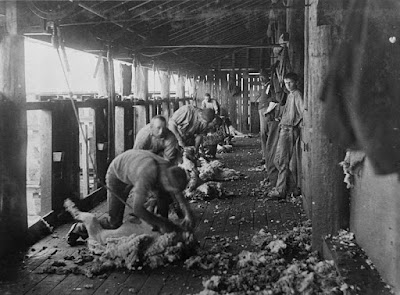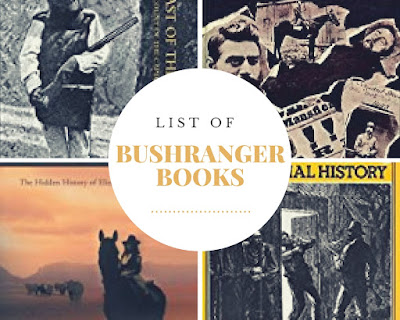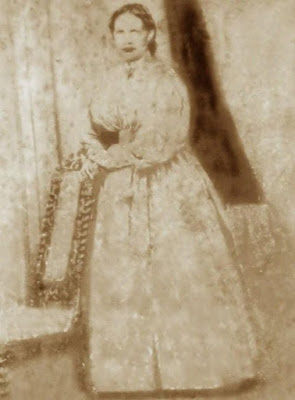 |
Joseph Bolitho Johns (1826 or 1830 - 1900) aka Moondyne Joe.
This is the only known photo of him. |
Born in Cornwall, England around 1826
Died Western Australia 13th August 1900
Why was famous He was Western Australia's best-known bushranger and renown for escaping from prison so many times as he loved freedom. He escaped so many times from Freemantle goal that his cell was wood lined, studded with bolts, and triple bars were placed on the window.
Joseph Bolitho Johns was the third child of blacksmith Thomas Johns and his wife Mary Bolitho. He was one of six children in a poor family and had to work as a copper miner with his brothers after his father died.
On 15 November 1848, Johns and William Cross, were arrested near Chepstow
for "... stealing from the house of Richard Price, three loaves of
bread, one piece of bacon, several cheeses, and other goods".[1] He was charged with burglary and stealing, the pair pleaded not guilty. On 23 March they were tried at the Lent Assizes before Sir William Erle.
Newspaper reports of the trial suggest that the pair gave an
unexpectedly spirited defence, but Johns was abrasive and "contravened
the conventions of court procedure". The men were convicted and
sentenced to ten years' penal servitude.
He came to be better known as Moondyne Joe. He goes down in history as Western Australia's best known bushranger known, not for his offences and crimes but, for being the person who had escaped multiple times from prison. Here is his brief history:
-
Johns and Williams were transferred to Millbank Prison
- transferred to Pentonville Prison to serve their mandatory six months of solitary confinement
- transferred to Dartmoor Prison on 21 October 1851
- Johns transferred to the Woolwich prison hulk Justitia, probably for disciplinary reasons
- transferred to the Defence when the Justitia was destroyed by fire
- transported to the British penal colony of Western Australia prison ship Pyrenees to serve out the remainder of his sentence
- arrived at Fremantle on 1 May 1853
- Granted an immediate ticket-of-leave on arrival in reward for good behaviour
- 1855 granted a conditional pardon
- worked at various tasks near Toodyay, in the Avon Valley, one of the most rugged and inaccessible places in the Darling Range. The Aboriginal name for the area was Moondyne
- arrested on a charge of stealing the local
magistrate's horse in 1861
- While awaiting trial he escaped from Toodyay
gaol but was recaptured to serve three years' imprisonment
- Released
- sentenced in 1865 to ten years for killing an ox with the
intent of stealing the carcass
- Determined not to serve this long
sentence and protesting his innocence, he made four attempts to escape from November 1865 to March
1867, three of which were successful. With two
companions, he was once at large for two months in the unsettled Darling
Range.
- Recaptured he was placed in irons in solitary confinement in a
specially reinforced cell with triple-barred windows at Fremantle gaol. He was only allowed out for exercise on medical advice.
- He escaped again in 1867
through a clever trick and for two years roamed the hill country east of
Perth.
- Recaptured while raiding a wine cellar and sentenced to a
further term in Fremantle prison. He was released in 1871 and gained
his conditional pardon in 1873.
The remainder of John's life consisted of periods of good behaviour
punctuated by occasional minor misdemeanors and brief jail terms. In
January 1879, he married a widow named Louisa Frances Hearn, née Braddick, and they spent some
time prospecting for gold near Southern Cross, in Western Australia. In 1881, while exploring the countryside around Karridale, in the south-west of Western Australia he discovered Moondyne Cave.
In his later years he became known locally, in Kelmscott where he lived after his wife's death, as 'Old Mad Moondyne Joe'. He was declared to be mentally ill and died of senile dementia in the Fremantle Lunatic Asylum on 13 August 1900. He was buried, in a paupers grave, in Fremantle Cemetery , his tombstone bearing the Welsh word for freedom - "rhyddid".
 |
| Illustration of Fremantle prison with image of Moondyne Joe on left by Ian Coates |
|
|
It was because the authorities found it
impossible to keep Moondyne behind prison walls that a cell in Fremantle
Gaol was specially prepared for him, and it remains today as it was
when he occupied it many years ago.
The walls of the confined space are heavily
timbered and appear to have been laboriously carved and patterned, but
is the triple-barred window which is of special interest. Moondyne
laughed at ordinary locks and bars and prison walls, but when he first
saw the cell prepared for him after many escapes, he must have realised
that he would never be able to break through the bars which covered the
small window space.
He became a romantic figure in the eyes
of the public, at the time, and after for his many escapes.
His determined bids for freedom inspired John Boyle O'Reilly,
a convict who escaped from Western Australia to the United
States, to write in 1887 a novel on convict life in Western Australia
featuring a fictitious and highly romantic Moondyne as central
character.
as central
character.
The Ballad of Moondyne Joe[2]
In the Darling Ranges, many years ago,
There lived a daring outlaw, by the name of 'Moondyne Joe'.
He stole the squatter's horses, and a sheep or two or three,
He loved to roam the countryside, and swore he would be free.
The troopers said we’ll catch him, but we know it's all in vain,
Every time we lock him up he breaks right out again.
'Cause in he goes, and out he goes, and off again he’ll go,
There's not a gaol in W.A. can keep in 'Moondyne Joe'.
 Mrs Kelly: the astonishing life of Ned Kelly's mother
Mrs Kelly: the astonishing life of Ned Kelly's mother True History of the Kelly Gang: A Novel by Peter Carey
True History of the Kelly Gang: A Novel by Peter Carey Ned Kelly's Last Stand - The Life and Times Australia's Ironclad Outlaw
Ned Kelly's Last Stand - The Life and Times Australia's Ironclad Outlaw







































